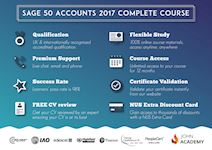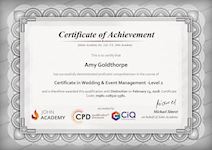Sage 50 Accounts 2017 Complete Course- Beginner to Advanced - CPD Certified
John Academy
Summary
Overview
Sage 50 accounts are the premium business management software in demand at the moment for small to medium sized businesses around the United Kingdom. This software is designed to help you manage your company’s accounting needs in a simple and straightforward manner. But if you want to utilize this great product, you need to know how to use it right; and that is why we have created this Sage 50 Accounts Complete Course- Beginner to Advanced for you.
This course has it all starting from the basics to advanced level instructions to help you master the Sage 50 accounts program. You will learn basic things like setting up the program, using the user interface and basic management of company details; until you move onto more advanced stuff like utilizing quotes and implementing customer discounts in different ways. You will also discover clear objectives in every chapter in order to help you identify the key points.
Overall this is a great course as the Sage 50 software can help you save money and time, which can be better utilized to grow your business. So if you want all your accounting related problems to go away, get this course now.
CPD
Course media
Description
Course Curriculum: Sage 50 Accounts for Beginner
Module 1: Program Basics– Set up your program, discover more about the user interface such as toolbar and keyboard options
Module 2: Restoring and Backing-up Data – Learn about data storage, creating back-ups and restoring them
Module 3: Basic Setting and Details – Manage financial dates, company details and program dates
Module 4: The Chart of Accounts – Create, modify and review chart of accounts
Module 5: Bank Receipts – Enter bank receipts
Module 6: Bank Payments – Oversee VAT, overheads, assets and bank payments
Module 7: Financials – Observe the financial state of your company
Module 8: Customers – Add new customers, use the new customer wizard, and manage their details
Module 9: Suppliers – Add and edit supplier records
Module 10: Working with Lists – Utilize lists to sort out records
Module 11: Batch Invoices – Create customer invoices, check bank accounts and nominals
Module 12: Service Invoices – Create service, manage line and invoice
Module 13: Processing Invoices – Process invoices and update ledgers
Module 14: Product and Services – Duplicate, add items, services and products
Module 15: Stock Control – Control your stocks through adjustments, activity and returns
Module 16: Product Invoices – Invoice management for products utilizing multiple platforms
Module 17: Product Credit Notes – Create credit notes
Module 18: Reviewing Your Accounts – Review the financial state of your company
Module 19: Aged Debtors and Statements – Analyse account balances, aged debtors, statements and customer communication history
Module 20: Customer Receipts – Allocate receipts automatically, manually or partially using discounts and payments on account
Module 21: Customer Activity – Observe customer activity
Module 22: Supplier Batch Invoices – Add new suppliers, their account balances and batch invoices
Module 23: Supplier Payments – Record and observe supplier payments, activity, print remittance and cheques
Module 24: More about the Nominal Ledger – Journal entries, nominal code activity, ledger graphs and records
Module 25: More about bank accounts – Learn about bank transfers, combined payments and petty cash transactions
Module 26: Using the Cash Register – Recording and depositing with the cash register
Module 27: Bank Reconciliation – Reconcile bank account and carry out group transactions
Module 28: Recurring Entries – Recurring entry processes including bank set up, adding journals, and deleting recurring entries
Module 29: VAT Returns – Produce, make, print, reconcile and complete VAT related transactions
Module 30: More About Reports – Follow the audit trail, period trial balance, profit and loss, and the balance sheet report
Module 31: Using Dashboards – Use the dashboards effectively
Sage 50 Accounts Intermediate Level
Module 1: Prepayments and Accruals – Setting up, processing and deleting prepayments & accruals.
Module 2: Fixed Assets & Depreciation – Understand the difference between assets and depreciation and their relationship in multiple forms.
Module 3: Delivery Address – Manage Company and customer’s delivery addresses
Module 4: Purchase Orders – Learn how to enter, edit, duplicate, print and process purchase orders
Module 5: Memorising Purchase Orders – Memorise and recall purchase orders
Module 6: Recording Deliveries – Manage delivery system for your clients on an elaborate scale
Module 7: More About Purchase Orders – Utilizing purchase orders in reference to supplier invoice and reports
Module 8: BOMs & Product Transfer – Create and Check BOMs and manage product transfers
Module 9: Product Pricing Options – Provide special prices, create, delete and move customers in price lists
Module 10: Sales Orders – Enter and manage sales orders, discounts and goods
Module 11: Recurring Sales Orders – Create, process and edit recurring sales orders
Module 12: Processing Sales Orders – Print, change, report sales orders and allocate stock, use Shortfall feature and much more
Module 13: Using Filters and Search – Use, set, save and clear filter options
Module 14: Credit Control – Learn about credit control basics
Module 15: Chasing Debts and Debt Analysis – Understand the chase debt view, send statements, account letters, add a communication and debt analysis
Module 16: Disputed Invoices – Recording disputes with customers, setting up dispute reasons, apply dispute in an invoice and clearing it
Module 17: Customer Refunds – Enter payment, process refunds and check transaction details
Module 18: Late Payment Legislation – Set up system for late payment, setting the customer record for credit charges, using credit charges wizard, and checking transaction details
Module 19: Writing Off Bad Debts –Write off bad debt, delete recurring sales and setting inactive flags
Module 20: Cash Flow Forecasting – Cash flow forecast, include and exclude bank accounts, sales and purchases
Sage 50 Accounts Advanced Level
Module 1: Company Review – Reviewing customer receipts, batch payments, and VAT reconciliation
Module 2: Cost of Sales (Closing Stock) – Calculating cost of sales, stock value, utilizing stock wizard
Module 3: Importing Data – importing customer records and other data
Module 4: Batch and Global Changes – Using batch changes and global changes on sales prices and from a supplier
Module 5: Customer Discounts – Discounts by invoice value, product quantity, copying a discount matrix, applying discounts to customer records and other discount methods
Module 6: Quotations –Learn about quotations and converting them, create a quotation and service quotes, and print quotations
Module 7: Winning and Losing Quotations – Winning and losing quotes, opening lost quotation and winning it, ordering stock and processing converted invoices
Module 8: Pro Froma Invoices – Creating a formal invoice, processing a payment on account, converting a pro from to a real invoice and allocating payment on account
Module 9: Contra Entries – Adding supplier invoice and entering contra entries
Module 10: The Audit Trail – Viewing and clearing audit trail, exporting to excel, printing audit trail report, and locking the date to prevent postings
Assessment and Certification:
Upon completion of the course, you will be required to sit an online multiple-choice test. Your test will be assessed automatically and the results will be given to you immediately. Before sitting your final exam you will have the opportunity to test your proficiency with a mock exam. After you have successfully passed the final exam, you will be able to order an Accredited Certificate of Achievement at an additional cost of £24 for a PDF copy and £39 for an original print copy sent to you by post.
Who is this course for?
- For beginners who are getting started with handling accounts.
- People who are interested in managing accounts through Sage 50 software.
Requirements
Our Sage 50 Accounts Complete Course-Beginner to Advanced is fully compatible with any kind of device.
Please Note: For practice purpose, you should have Sage 50 software installed on your PC. The software is not included with this course. Sage provide a free online trial version of the Sage 50 Accounts software, which is more than suitable to study this course and learn how to use the software. You will get the full instructions for downloading free Sage 50 Software in your course page.
Questions and answers
Is the cost for the exam included within the price?
Answer:Hi Louise, Thank you for your question. At the end of the course, you will be able to sit a mock exam and then the final exam. Both exams are held online and they will be in multiple choice format. This is included within the price. Regards, Help Desk
This was helpful.I want to go through sage line 50 for accounting I d like to Get step by step in regards the sage50 for accounting . I have experience in accounting
Answer:Hi Servio, Thanks for your query. It's fantastic that you have experience in the sector! This course will develop and enhance your knowledge of using Sage 50 Accounting software and it covers the most up-to-date version of the build! Regards, Help Desk
This was helpful.
Reviews
Currently there are no reviews for this course. Be the first to leave a review.
Legal information
This course is advertised on reed.co.uk by the Course Provider, whose terms and conditions apply. Purchases are made directly from the Course Provider, and as such, content and materials are supplied by the Course Provider directly. Reed is acting as agent and not reseller in relation to this course. Reed's only responsibility is to facilitate your payment for the course. It is your responsibility to review and agree to the Course Provider's terms and conditions and satisfy yourself as to the suitability of the course you intend to purchase. Reed will not have any responsibility for the content of the course and/or associated materials.




